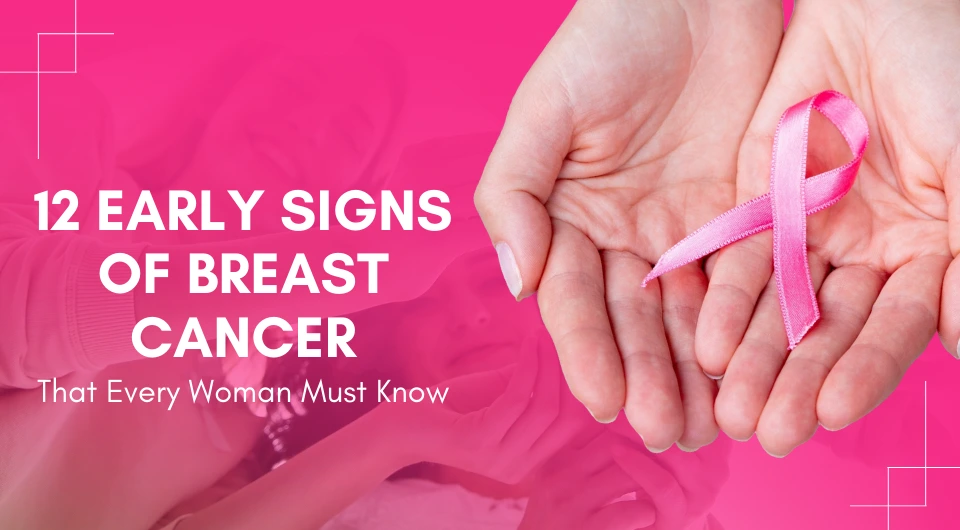Breast cancer is one of the most prevalent and life-altering diseases affecting women globally. According to the World Health Organization, breast cancer accounts for 685,000 deaths each year worldwide. In 2020 alone, an estimated 2.3 million new cases of breast cancer emerged, marking a significant presence as 1 out of every 8 cancers diagnosed worldwide was related to breast cancer. This data highlights the enormous impact of this disease, emphasizing the importance of recognizing the first signs of breast cancer, which can have a significant impact on survival rates and treatment outcomes.
About Breast Cancer
Breast cancer is a type of cancer that forms in the cells of the breast. It occurs when abnormal cells in the breast grow and multiply uncontrollably, forming a tumor. These cancerous cells can invade nearby tissues and, in advanced stages, may spread to other parts of the body, a process known as metastasis.
There are various types of breast cancer, and they can be classified based on where in the breast they originate, such as the ducts or lobules, and how aggressive they are.
Common types of breast cancer include:
- Ductal Carcinoma In Situ (DCIS): DCIS is a non-invasive type of breast cancer where abnormal cells are confined within the milk ducts, without spreading to surrounding tissue. Early detection of DCIS offers a high survival rate and various treatment options, including surgery and radiation therapy.
- Invasive Ductal Carcinoma (IDC): This type involves cancer cells breaking through the duct walls, and spreading to nearby tissues. IDC is the most common type of breast cancer, accounting for approximately 80% of cases. Timely diagnosis and treatment are critical for better outcomes.
- Invasive Lobular Carcinoma (ILC): ILC originates in the lobules or milk-producing glands and can spread to other parts of the breast. It comprises about 10-15% of invasive breast cancers and might require distinct treatment approaches compared to IDC.
- Metastatic Breast Cancer: Metastatic breast cancer, also known as stage IV or advanced breast cancer, occurs when cancer cells from the breast have spread to other parts of the body, such as the bones, liver, lungs, or brain. Detecting metastatic breast cancer often indicates an advanced stage, impacting treatment options and prognosis.
Breast cancer staging plays a pivotal role in determining the extent of cancer spread and guiding treatment decisions. It ranges from stage 0 to stage IV:
| Stage | Description |
| Stage 0 | Non-invasive breast cancer confined within the milk ducts (e.g., DCIS) |
| Stage I & II | Early-stage invasive breast cancer localized in the breast or nearby lymph nodes |
| Stage III | Locally advanced breast cancer with a more extensive tumor and potential spread to nearby lymph nodes and hasn’t yet affected distant organs. |
| Stage IV | Advanced breast cancer; cancer cells have spread to distant body organs such as bones, liver, lungs, etc. |
Knowing the stage aids in devising an effective breast cancer treatment plan, significantly influencing the prognosis.
What are the Early Signs of Breast Cancer?
Many women usually overlook the subtle signs and symptoms of breast cancer, which they are mostly unaware of. A breast cancer diagnosis at an early stage can result in better survival rates and timely medical attention.
Listed below are breast cancer warning signs every woman should be aware of

1.Changes in Breast Size or Shape
Spotting any differences in how your breasts look or feel is important. Sometimes, changes in size or shape might happen for different reasons, but noticing asymmetry or a change in how your breasts sit could be an early sign of breast cancer. This might show up as a lump, unexplained swelling, distortion, or thickening that you can feel. These changes might be visible or palpable, such as a lump or thickening.
2.Breast Pain- A Sign of Breast Cancer?
Breast pain, often termed mastalgia, is a commonly experienced sensation by many women and is common but not always a cause for concern.
Persistent or unusual pain in the breasts or nipples could be an early signal of breast cancer. Note any unexplained tenderness, discomfort, or pain that persists through the menstrual cycle.

3. Do Changes in Skin Signs of Breast Cancer?
Skin changes on the breast’s surface serve as one of the potential physical signs of breast cancer. Sometimes, the skin might resemble an orange peel texture (peau d’orange), which manifests as a dimpled or pitted appearance on the surface of the breast skin, just like the skin of an orange. Peau d’orange typically arises due to fluid accumulation in the breast’s lymphatic vessels, causing them to swell and creating the characteristic dimple (or indentation). Therefore, observe for skin changes on the breast’s surface, including redness, scaliness, puckering, dimples, etc.
4. Nipple Changes
Watch out for any changes in your nipples, like turning inward (inverted) or suddenly pulling in (sunken nipple). A sunken nipple, especially if it’s an unexpected shift or a sudden change in appearance, could be a vital indicator of underlying breast concerns, including the possibility of early signs of breast cancer. This alteration might not always be a cause for alarm, as some individuals naturally have inverted nipples. However, it’s essential not to dismiss it when it appears suddenly or is accompanied by other changes in the breast, such as skin puckering or unusual lumps.
Checking your nipples regularly for any new changes or unexpected discharge is important for catching any potential concerns early on and getting the right help if needed.
5. Swollen Lymph Nodes
Enlarged lymph nodes under the armpit or around the collarbone can signal breast cancer spread. Regularly check for any unexplained swelling or tenderness in these areas.
Lymph nodes are part of the body’s defense system and can enlarge if they are fighting an infection or dealing with cancer cells. If you notice any unusual swelling or tenderness that doesn’t go away, it’s important to bring it to the attention of your healthcare provider.
6. Persistent Breast Sensitivity
If you experience ongoing breast sensitivity or discomfort that isn’t linked to your menstrual cycle, it’s important to take it seriously. Persistent tenderness or sensitivity in your breasts, unrelated to your monthly cycle, should raise concerns and prompt you to seek medical advice. Even though breast sensitivity is often associated with hormonal changes during the menstrual cycle, continuous discomfort that doesn’t follow this pattern needs a thorough evaluation, as it may be an early sign of breast cancer.
7. Changes in Breast Skin Temperature
The appearance of redness or heat in the breast area can be a potential sign of inflammatory breast cancer, a less common but aggressive form of breast cancer. Unlike other signs of breast cancer that typically present with lumps or masses, IBC may not always manifest as a distinct lump but instead causes the affected breast to appear red, swollen, and inflamed. The skin may take on a reddish or purplish hue, feeling warm or even hot to the touch. Alongside redness, the breast may feel tender, itchy, or painful. Inflammatory breast cancer progresses rapidly, and these symptoms can develop quickly, sometimes over a matter of weeks.
8. Unexplained Weight Loss
Losing weight without intending to, especially when there haven’t been any changes in your diet or exercise routine, could be an early sign of metastatic breast cancer. Weight fluctuations can occur due to various reasons, such as lifestyle changes or health conditions. Unexplained weight loss, particularly when combined with other symptoms of breast cancer, may require immediate medical attention.
9. Unusual Breast Discharge
Normally, nipple discharge might occur due to hormonal changes, pregnancy, breastfeeding, or certain medications.
Bloody discharge, also referred to as bloody nipple discharge (BND), or clear discharge that occurs without any manipulation, can arise from several breast conditions like intraductal papillomas, ductal ectasia, or, in rare instances, breast cancer. While such discharge can stem from benign causes, the critical concern surfaces when it becomes abnormal—bloody, clear, or spontaneous without stimulation. This aberrant discharge is a red flag, potentially signaling an underlying issue, even an early sign of breast cancer.
10. Unusual Bone Pain
Bone pain, a prevalent sign of metastatic breast cancer, frequently presents as aching, dull, or sharp discomfort within the bones. This sensation commonly emerges due to the invasion of cancer cells into bone tissue, leading to structural changes and damage. While bone pain can affect any bone throughout the body, it typically manifests in areas such as the spine, ribs, pelvis, or the long bones of the arms and legs.
11. New Veins
“Prominent veins” are considered a less frequent symptom associated with early signs of breast cancer, typically categorized within broader classifications such as “unusual alterations” or “changes in skin appearance.” The sudden appearance of new blood vessels or increased visibility of veins on the breast surface does not typically indicate cancer. Instead, it is commonly attributed to factors such as weight fluctuations, breastfeeding, or Mondor’s disease, a condition causing inflammation in chest wall veins.
12. Crusty Nipple Skin
The presence of a crust or scab on the nipple is often attributed to various benign skin conditions, including eczema or dermatitis, which may cause dryness, flakiness, or irritation in the nipple area. Additionally, during breastfeeding, nipple skin can become dry and develop small cracks, leading to crust formation, a common occurrence often resolved with proper care and moisturization.
However, in certain cases where skin remedies or typical treatments fail to solve the issue, it could potentially be a sign of a rare type of breast cancer known as “Paget’s disease.”
What Causes Breast Cancer?
Breast cancer is a complex disease influenced by various factors, and while the precise cause of breast cancer isn’t fully understood, several factors contribute to its development.

Some of the key factors associated with an increased risk of breast cancer include
Risk factors you can’t control:
Genetic factors
Hereditary gene mutations
Inherited gene mutations, such as BRCA1 and BRCA2 tumor suppressor genes, significantly escalate the risk of breast cancer. However, these mutations are responsible for only a small percentage (about 5-10%) of breast cancer cases. Less common gene mutations like TP53, PALB2, ATM, or CHEK2 can also contribute to increased risk.
Family history of Breast or ovarian cancer
A higher risk of breast cancer occurs when a woman has a first-degree relative (mother, sister, or daughter) or multiple family members on either side (maternal or paternal) with a history of breast or ovarian cancer. Additionally, even if a woman has a first-degree male relative diagnosed with breast cancer, her risk also increases.
Physical factors
Age
The risk of breast cancer rises as individuals age, with a majority of cases occurring in women over 50. As age increases, so does the risk.
Reproductive history
Longer exposure to estrogen over a lifetime, such as the early onset of menstruation (before age 12), late menopause (over the age of 50), or never having given birth, can heighten the risk of breast cancer.
Having dense breasts
Having dense breast tissue (which means having more connective tissue than fatty tissue in the breasts) is linked to a higher risk of breast cancer. It is because, usually, dense tissues may hide the tumors, making them difficult to detect; therefore, the late detection of cancer.
Previous history of breast cancer or certain noncancerous breast disease
Women previously diagnosed with breast cancer face an increased likelihood of experiencing a recurrence. Additionally, certain non-cancerous breast conditions, like atypical ductal hyperplasia or lobular carcinoma in situ, elevate the risk of developing breast cancer again.
Race and ethnicities
According to the American Cancer Society, there is a slightly lower likelihood of black women and individuals assigned female at birth (AFAB) developing breast cancer compared to white women. However, despite this lower incidence, black women face a higher probability of dying from breast cancer in comparison to white women.
Risk factors you can control:
Lifestyle factors
Obesity
After reaching menopause, being overweight or obese might increase your susceptibility to breast cancer. This heightened risk is associated with higher estrogen production in your body due to excess weight post-menopause.
Consuming Alcohol
Consuming alcohol heightens the likelihood of developing breast cancer. Even minimal and regular alcohol intake raises the risk of acquiring breast cancer compared to abstaining from alcohol entirely. Furthermore, the greater the quantity of alcohol consumed, the higher the risk of developing breast cancer.
Medications and Medical Procedures
Exposure to DiEthylStilbestrol (DES)
Diethylstilbestrol (DES) is a synthetic form of estrogen that was prescribed to pregnant women in the mid-20th century to prevent miscarriages. However, it was later discovered that exposure to DES during pregnancy could have adverse effects on the offspring, including a slightly increased risk of certain health conditions, including a slightly higher risk of breast cancer in daughters whose mothers were administered DES during pregnancy.
Previous Exposure to Radiation
Certain medical procedures, such as radiation therapy for other conditions, especially when applied to the chest area (such as Hodgkin’s lymphoma), during childhood or adolescence, could potentially elevate the risk of developing breast cancer in the future.
Contraceptive pills
Studies indicate that women using contraceptive pills experience a slight elevation in the risk of developing breast cancer. Nevertheless, upon discontinuation of the pill, the risk begins to decline. Approximately a decade after cessation, the risk of breast cancer returns to a normal level.
Hormone replacement therapy (HRT)
All forms of HRT, excluding vaginal estrogen, have the potential to elevate this risk. Compared to women who do not use HRT, the risk of breast cancer increases if HRT use continues for more than a year.
After stopping hormone replacement therapy, the higher risk of breast cancer declines, but for some women, the elevated risk lasts for over ten years compared to those who have never used HRT.
| Did You Know? 💡
Contrary to popular belief, male breast cancer, though rare, affects approximately 0.5–1% of all breast cancer cases. |
Breast Cancer Survival Rates
The significant advancements in detecting the early signs of breast cancer have contributed immensely to improving survival rates. These rates differ based on several variables, such as the type of breast cancer, the individual’s health, and the stage of cancer at diagnosis.
| Breast Cancer Stage | Description | Five-year Survival Rate |
| Local | Cancer remains confined within the breast area. | 99% |
| Regional | Nearby lymph nodes and tissue have been affected by cancer. | 86% |
| Distant | Cancer has metastasized to distant organs like the liver or lungs. | 30% |
These survival rates underscore the critical need for regular screenings, self-examinations, and awareness of the early signs of breast cancer. Prompt action upon noticing any concerning symptoms greatly enhances the chances of early detection, leading to more effective treatment and higher survival rates.
Diagnosing Breast Cancer
Diagnosing early signs of breast cancer involves a comprehensive array of tests and procedures meticulously designed to swiftly identify and conclusively confirm the presence of any irregular cells within the breast tissue. These diagnostic methods play a pivotal role in early detection, thereby enhancing the chances of successful treatment and improved prognosis.

Let’s go into detail about the various methods commonly utilized in diagnosing early signs of breast cancer:
- Mammogram
The method involves using X-ray imaging to determine if there are any abnormalities in the breast, such as slight lumps or microcalcifications, that might indicate cancer is already in its early stages.
- Clinical Breast Exam
This physical examination of the breasts and lymph nodes detects any perceptible changes or indicators of breast cancer.
- Ultrasound
Utilizing sound waves to generate detailed images of the breast tissue, ultrasounds prove instrumental in distinguishing between solid masses and fluid-filled cysts. This non-invasive method aids in identifying any tumor of breast cancer that may not be easily visible through other means.
- MRI (Magnetic Resonance Imaging)
Using powerful magnets and radio waves, MRI scans produce detailed images of the breast. This technique is often utilized with other diagnostic tests to capture a more complete picture, aiding in the detection of first signs of breast cancer that might otherwise go unnoticed.
- Biopsy
Considered the gold standard for definitive diagnosis, a biopsy involves the extraction of a small sample of tissue from the suspicious area within the breast for detailed examination under a microscope.
Types of biopsies, including fine-needle aspiration (FNAC), core needle biopsy, and surgical biopsy, play an important role in confirming breast cancer and determining the appropriate course of treatment.
In conclusion, a comprehensive approach involving these diagnostic methods is crucial in the timely identification of breast cancer. Regular screenings and prompt medical attention upon noticing any unusual changes in the breast play a pivotal role in ensuring early detection and effective treatment, thereby significantly improving the chances of a positive outcome.
Treating Breast Cancer
Treatment plans for breast cancer are individualized based on factors such as cancer stage, type, and the patient’s overall health.
Common treatment modalities include
- Surgery: Depending on the cancer stage, surgical options may include lumpectomy (removal of the tumor and a small portion of surrounding tissue) or mastectomy (removal of the entire breast).
- Radiation Therapy: High-energy rays target and destroy cancer cells after surgery or as a primary treatment to shrink tumors.
- Chemotherapy: Medications administered orally or intravenously to kill cancer cells or shrink tumors. It can be used before surgery to shrink tumors or after to eliminate remaining cancer cells.
- Hormone Therapy: Used for hormone receptor-positive breast cancers, this treatment blocks hormones or lowers their levels to prevent cancer cells from growing.
- Targeted Therapy: Medications that specifically target proteins or genes involved in cancer growth, often used alongside other treatments.
Immunotherapy: Boosts the body’s immune system to recognize and destroy cancer cells, a newer approach showing promise in certain breast cancer types.
Conclusion
Stay vigilant about these early signs of breast cancer and consult healthcare professionals for evaluation and guidance can significantly impact early detection and subsequent treatment outcomes. Remember, early detection can save lives. Make self-examinations and regular screenings a priority, and together, we can continue to fight breast cancer with strength and resilience.





